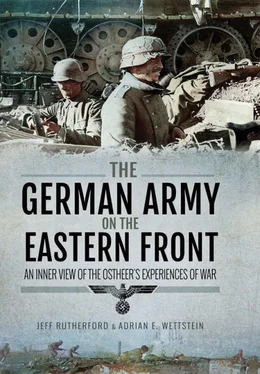Grenadier-Regiment 186, Betr.: Zustandsbericht, 2.11.42, BA-MA RH 26-73/22.
Comparisons between the US and German army from 1939 to 1945 have led to many publications. The classic work is Martin van Creveld, Combat Power ; for a comparison suffering from the problems mentioned above, see Keith Bonn, Where the Odds were Even .
8. Panzer Division/Ia, Betr.: Ausbildung, 7.1.42, NARA T-315, Roll 484.
125. Infanterie-Division/Ia, Anlage einer Muster-Kampfschule, [1943] BA-MA RH 26-125/26.
OKH/Generalstab des Heeres/Ausb.-Abt./Org.-Abt., Betr.: Ausbildungsmöglichkeiten im Feld-Ersatz-Bataillon der Divisionen im Osten, 1943, BA-MA RH 24-59/80.
The German army’s table of organization used a letter to signify all positions, marking which rank the man in the position should normally possess. B stands for Bataillonskommandeur which corresponds to the rank of Oberstleutnant or Major .
When possible, German units had a small reserve of officers and NCO not posted to positions, but ready to take over any command when officers or NCOs were killed, wounded or otherwise lost, to avoid long vacancies in ongoing operations. Often, the forming of such a leader reserve was not possible due to the general shortage of officers and NCOs, and even if such a reserve existed, it was frequently depleted after a few days of operations.
Armee-Oberkommando 6/Ia, Betr.: Erfahrungen 300er Divisionen, 26.10.1942, BA-MA RH 20-6-227.
For a detailed study on the 385th Infantry Division and its leadership, see Marco Sigg, Der Unterführer als Feldherr im Taschenformat , pp. 262-323.
5. Panzer-Division/Ia, Betr.: Erfahrungen mit neu aufgestellten Einheiten im Einsatz, 2.1.44, BA-MA RH 20-2/557.
Armee-Oberkommando 6/Ia, Betr.: Erhöhung der Kampfkraft, 6.10.42, BA-MA RH 20-6/220.
Armee-Oberkommando 6/Ia, Vom AOK 6 befohlene Massnahmen zur Hebung der Gefechtsstärken, 28.10.42, BA-MA RH 20-6/22.
OKH/GenStdH/General der Osttruppen/Org.Abt, Landeseigene Hilfskräfte im Osten, 29.4.43, BA-MA RHD 7/8a/3.
Armee-Oberkommando 6/Ia, Betr.: Erhöhung der Kampfkraft, 6.10.42, BA-MA RH 20-6/220.
Antony Beevor, Stalingrad: The Fateful Siege, 1942-43 , pp. 161.
Germany and the Second World War , volume 5/2, p. 943.
Armee-Oberkommando 6/Ia, Betr.: Erhöhung der Kampfkraft, 6.10.42, BA-MA RH 20-6/220.
Numbers in Germany and the Second World War , Volume 6, pp. 865-7.
Numbers in Germany and the Second World War , Volume 5/2, p. 1013.
H.R., 29.01.1943, Feldpost Sammlung, Museum für Kommunikation (hereafter MfK), 3.2002.0985.
E.A. Shils, and Morris Janowitz, ‘Cohesion and Disintegration in the Wehrmacht in World War II,’ POQ, 12 (1948), 280-315; Creveld, Fighting Power .
Ronald Smelser and Edward J. Davies II, The Myth of the Eastern Front: The Nazi-Soviet War in American Popular Culture ; Wolfram Wette, The Wehrmacht: History, Myth, Reality .
Hans-Adolf Jacobson, ‘The Commissar Order and the Mass Execution of Soviet Prisoners of War,’ in Hans Bucheim et al., Anatomy of the SS State , pp. 163-283; Christian Streit, Keine Kameraden. Die Wehrmacht und die sowjetischen Kriegsgefangen 1941-1945 ; Jürgen Förster, ‘Operation Barbarossa as a War of Conquest and Annihilation,’ in Boog et. al, The Attack on the Soviet Union .
Bartov, Hitler’s Army .
Sönke Neitzel and Harald Welzer, Soldaten: Protokolle von Kämpfen, Töten und Sterben .
Sven Oliver Müller, ‘Nationalism in German War Society 1939-1945,’ in Jörg Echternkamp (ed.) German Wartime Society 1939-1945: Exploitation, Interpretations, Exclusion , volume 9/2, Germany and the Second World War , pp. 11-93; Nicholas Stargardt, The German War: A Nation under Arms, 1939-1945 .
Hürter, ‘Die Wehrmacht vor Leningrad,’ Vierteljahrshefte für Zeitgeschichte , 49 (2001), 377-440; Rutherford, Combat and Genocide , Oldenburg, Ideologie und militärisches Kalkül .
Jürgen Förster, ‘Ideological Warfare in Germany, 1919 to 1945’ in Jörg Echternkamp (ed.) German Wartime Society 1939-1945: Politicization, Disintegration, and the Struggle for Survival , volume 9/1, Germany and the Second World War , pp. 485-669.
Hew Strachan, ‘Ausbildung, Kampfgeist und die zwei Weltkriege,’ in Bruno Thoß and Hans-ErichVolkmann (eds.), Erster Weltkrieg. Zweiter Weltkrieg , pp. 265-286; Frank Vossler, Propaganda in die eigene Truppe. Die Truppenbetreuung in der Wehrmacht 1939-1945 , pp.19-37.
8. Panzer Division/Kommandeur, 25.3.1943, NARA T-315, Roll 498.
Wilhelm Deist, The Wehrmacht and German Rearmament , p. 34.
Anlage 4 zu Ob.d.H./GenStdH/O.Qu.I, Nr. 500/40 g., 7.10.40, BA-MA RH 26-123/173.
7. Infanterie-Division/Ia, Besondere Anordnungen zum Divisionsbefehl für 2.7.41, 1.7.1941, NARA T-315, Roll 373.
Chronik der 2. Kompanie Nachrichten-Abteilung 121, BA-MA RH 44/381.
121. Infanterie-Division/Ic, 21.6-19.11.1941, Abschrift: Zusammenstellung von Beobachtungen über die Rote Armee (von A.E. Frauenfeld), o.D., BA-MA RH 26-121/70.
Alfred Frauenfeld was an Austrian Nazi who served with the Luftwaffe’s propaganda troops in France, in the Balkans and the Soviet Union and later became Generalkommissar for Crimea. See Werner Bräuninger, ‘Meisterstück falscher Behandlung. Alfred E. Frauenfeld und die Probleme der Verwaltung der besetzten Ostgebiete,’ in Werner Bräuninger, Hitlers Kontrahenten in der NSDAP. 1921–1945 , pp. 247–257.
Der Todesmarsch nach Leningrad, BA-MA MsG 2/2580, pp. 151-2.
For more on the spiraling of violence on the Eastern front as a result of both German and Soviet atrocities, see Römer, Der Kommissarbefehl , pp. 226-275.
Mark Edele and Michael Geyer, ‘States of Exception: The Nazi-Soviet War as a System of Violence, 1939-1945,’ in Michael Geyer and Sheila Fitzpatrick (eds), Beyond Totalitarianism: Stalinism and Nazism Compared , pp. 345-395.
7. Infanterie-Division/Ic, Die Feindlage, 19.12.1941, NARA T-315, Roll 376.
During the First World War, Austro-Hungarian, Russian, and German forces clashed in the Carpathian Mountains, in the northwestern section of the Habsburg Empire. The fighting in 1915 was particularly hellish for the belligerent armies and their soldiers. See Graydon Tunstall, Blood on the Snow: The Carpathian Winter War of 1915 .
Читать дальше






![John Stieber - Against the Odds - Survival on the Russian Front 1944-1945 [2nd Edition]](/books/405234/john-stieber-against-the-odds-survival-on-the-russian-front-1944-1945-2nd-edition-thumb.webp)





